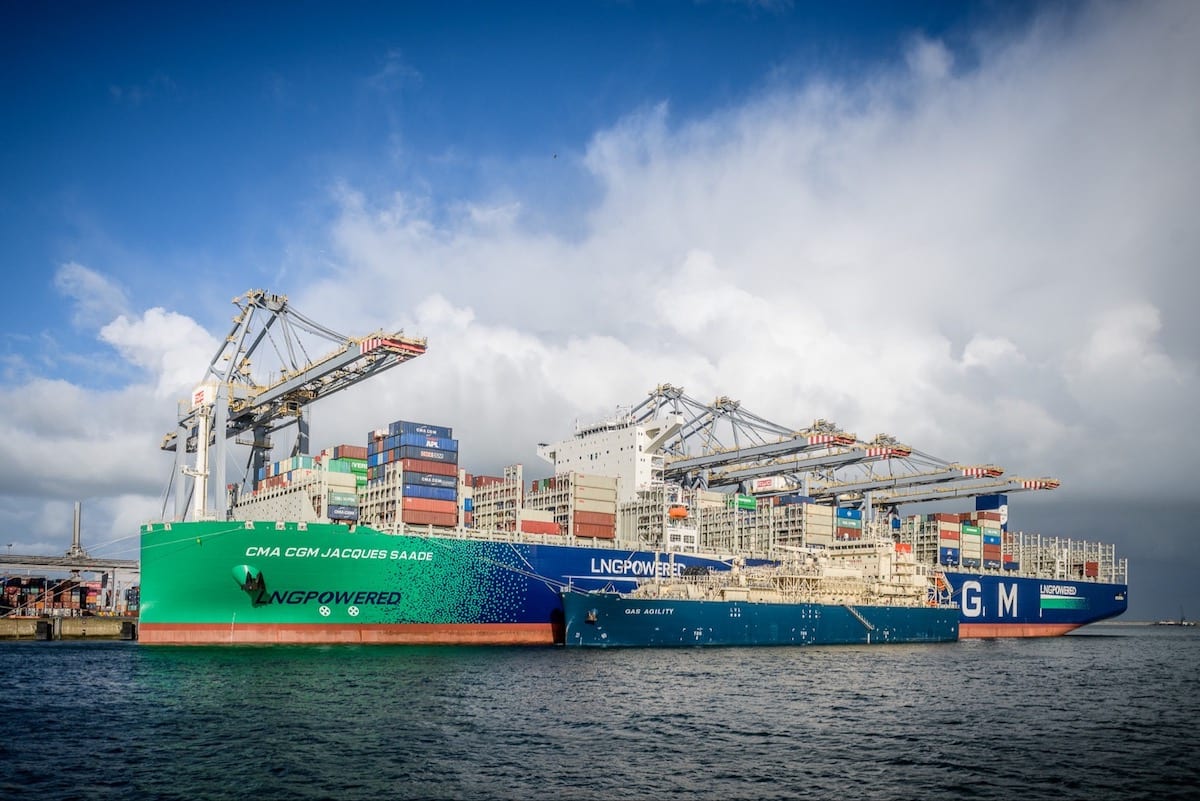Image (c) Shutterstock/Oleksandr Kalinichenko
Ann Koh and Christine Buurma
Oct. 31 (Bloomberg) — Oil’s collapse is eroding the appeal of potential U.S. LNG exports to Asia as it cuts the cost of competing supplies linked to the price of crude.
Brent’s 22 percent drop this year outpaced the 8.9 percent decline in natural gas at Henry Hub, the benchmark for U.S. liquefied natural gas shipments that are scheduled to begin in 2015. When the cost of processing and shipping American supplies to Asia is taken into account, the price advantage over oil- linked cargoes from producers such as Qatar has more than halved, according to data compiled by Bloomberg.
While the U.S. shale boom prompts the world’s biggest natural gas producer to plan exports of the fuel, it’s also boosting the country’s crude output to the most in 30 years, helping drive down global oil prices.
“The U.S. will not sell cheap gas,” Umar Jehangir, the deputy secretary of development and joint ventures at Pakistan’s Petroleum and Natural Resources Ministry, said in Singapore on Oct. 29, adding that the opinion was his own. “U.S. LNG will be exactly the same price as gas coming out of Qatar to Asia.”
Cheniere Energy Inc., which is set to become the first natural gas exporter from the U.S. shale boom when its Sabine Pass terminal in Cameron Parish, Louisiana, starts next year, says the economics still make sense. Even after crude’s slump, there’s a 15 percent gap between Henry Hub-indexed prices and oil-linked supplies, Jean Abiteboul, the president of Cheniere Supply & Marketing, said in London on Oct. 29.
Price Difference
Assuming Henry Hub prices of $4 per million British thermal units and Brent crude at $100 a barrel, U.S. LNG delivered to Asia would be $3.90 per million Btu cheaper than oil-linked supplies after a $3.50 liquefaction fee and $3 shipping is added, Cheniere said in a May presentation on its website.
With Brent at $87.12 a barrel as of Oct. 29 and U.S. natural gas at $3.728 per million Btu, the gap shrinks to $2.28, all else being equal. If Commerzbank AG’s forecast for $85 Brent and $5 per million Btu natural gas next year are accurate, the difference will be about 50 cents. It was $5.26 at the end of last year.
“At $80 a barrel, U.S. LNG is competitive,” Laszlo Varro, the head of gas, coal and power at the International Energy Agency, said in an Oct. 28 interview in Singapore. “At $70 to $75, oil-linked and Henry Hub are roughly the same.”
Sempra Energy
Advances in drilling techniques including hydraulic fracturing have pushed U.S. natural gas output to a record every year since 2011 and made the country the world’s largest producer. Dominion Resources Inc.’s Cove Point terminal in Maryland last month became the fourth U.S. export project to win permission from the Federal Energy Regulatory Commission to ship LNG around the world.
Sempra Energy got FERC approval for its Cameron export terminal in Louisiana in June. Full commercial operations are planned in 2019.
“While natural gas and oil-index prices are subject to future market price changes, we believe North American natural gas will continue to be an attractive choice to meet global demand based upon the availability of supply, access and delivery options, competitive market pricing (e.g. Henry Hub) and government stability,” San Diego-based Sempra said in an e- mailed statement.
Lisa Singleton, a spokeswoman for Freeport LNG Development LP, which is planning a $14 billion export terminal in Texas, declined to comment. Diane Haggard, a spokeswoman for Houston- based Cheniere couldn’t immediately make an executive available to comment. Nobody replied to an e-mail and call to the press office of Dominion.
Asian Buyers
West Texas Intermediate for December delivery decreased 18 cents, or 0.2 percent, to $80.94 a barrel at 1:48 p.m. Singapore time. Brent lost 31 cents to $85.93.
Asia is the prime market for U.S. supplies, with the region forecast to consume 75 percent of the world’s LNG over the next five years, according to IEA estimates.
The U.S. export facilities are selling gas under long-term contracts, typically of about 20 years, which will give both buyers and sellers some protection against some price fluctuations.
Tokyo Gas Co., Japan’s biggest city-gas distributor, agreed in July to buy about 520,000 metric tons a year from the Cameron project for 20 years starting 2020. GAIL India Ltd. will take 3.5 million tons a year for two decades from Sabine Pass and has also booked capacity at Cove Point.
All else being equal, crude would have to fall below $70 a barrel to make long-term oil-linked contracts competitive against North American LNG, Kazuo Yoshino, chief financial officer at Tokyo Gas, said at a press conference yesterday. Even if they are cheaper, the company will still buy U.S. shipments because it wants to diversify its supply sources, he said. Brent crude for settlement in December 2019 is currently priced at $91.67 a barrel, according to Bloomberg fair value data. Henry Hub gas is at $4.526 per million Btu.
“U.S. LNG is a reality,” said Hiroki Sato, general manager of fuels at Chubu Electric Power Co., Japan’s second- biggest buyer of LNG.
–With assistance from Emi Urabe in Tokyo and Yee Kai Pin in Singapore.
Copyright 2014 Bloomberg.
Unlock Exclusive Insights Today!
Join the gCaptain Club for curated content, insider opinions, and vibrant community discussions.

 Join The Club
Join The Club













